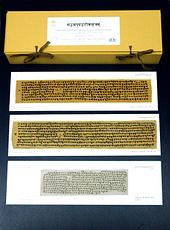⑫Gilgit Lotus Sutra Manuscripts from the National Archives of India, Facsimile Edition (2012)
Published by the National Archives
of India, the Soka Gakkai and the Institute of Oriental Philosophy
Date of publication: March 24,
2012
ISBN: 978-4-88417-031-8
Edited by Noriyoshi Mizufune
Copy date: 6th-7th centuries CE
Number of folios: xxxii + 235 + 10
(total 277 folios)
Type of publication: color
facsimile
Language: Sanskrit, English, and Japanese
----------------------------------------------------------------------------------------------------------------------------------
Many Buddhist scriptures were
found at a site where monks had lived in Naupur near Gilgit (presently
controlled by Pakistan) in Kashmir, in 1931. They included manuscripts of the
Sanskrit Lotus Sutra. Most of them were written on birch bark that had not
decayed or decomposed. The near-freezing temperature there was also helpful in
preserving them over the centuries. Some of them were written on paper, which are
seemingly very early paper products, and imoirtant material for the history of
paper.
The
manuscripts of the Lotus Sutra belong to the oldest ones we know of, which can
be classified into three groups: A, B, and C. Fortunately, colophons to Group A
and Group C are preserved. The colophons are very precious because they mention
the donors’ names and their positions, and suggest how the faith in the Lotus
Sutra during that period was really like.
Most
of the Lotus Sutra manuscripts are preserved at the National Arechives of
India, though some remain outside India. In 1974, Raghu Vira, Founder of the
International Academy of Indian Culture, and his son, Lokesh Chandra, Director
of the International Academy of Indian Culture, first published a facsimile edition
of the voluminous Gilgit manuscripts of the Lotus Sutra from the National Archives.
In 1982, Oskar von Hinüber published fragments of 30 folios, which are
preserved today in Kashmir, as A New
Fragmentary Gilgit Manuscript of the Saddharmapuṇḍarīkasūtra.
This
color facsimile edition of the Lotus Sutra manuscripts preserved at the
National Archives of India was published in cooperation with the Archives, Dr.
L. Chandra, and Dr. von Hinüber.
The
article dedicated to the publication, “The Saddharmapuṇḍarīkasūtra at Gilgit:
Manuscripts, Worshippers, and Artists” by von Hinüber reads, “All those
observations around the Saddharmapuṇḍarīkasūtra manuscripts demonstrate that
this text was firmly ebedded in the Buddhist culture of Gilgit during the reign
of the Palola Ṣāhis from the late sixth to the early eighth centuries.
The literary tradition of the text was cultivated by copying manuscripts of the
Saddharmapuṇḍarīkasūtra. As far it is possible to draw conclusions from the
colophons, these manuscripts were used in worship… Consequently, the Saddharmapuṇḍarīkasūtra
manuscripts recovered from the Gilgit Library not only preserve for the first
time, without being complete however, large parts of the text. For the presence
of the Saddharmapuṇḍarīkasūtra is, moreover, felt in many areas of Buddhist
religion and Buddhist culture in ancient Gilgit. This is by far more than any
other find of manuscripts from ancient Indian can tell about the immediate
impact of the Lotus Sūtra.”












